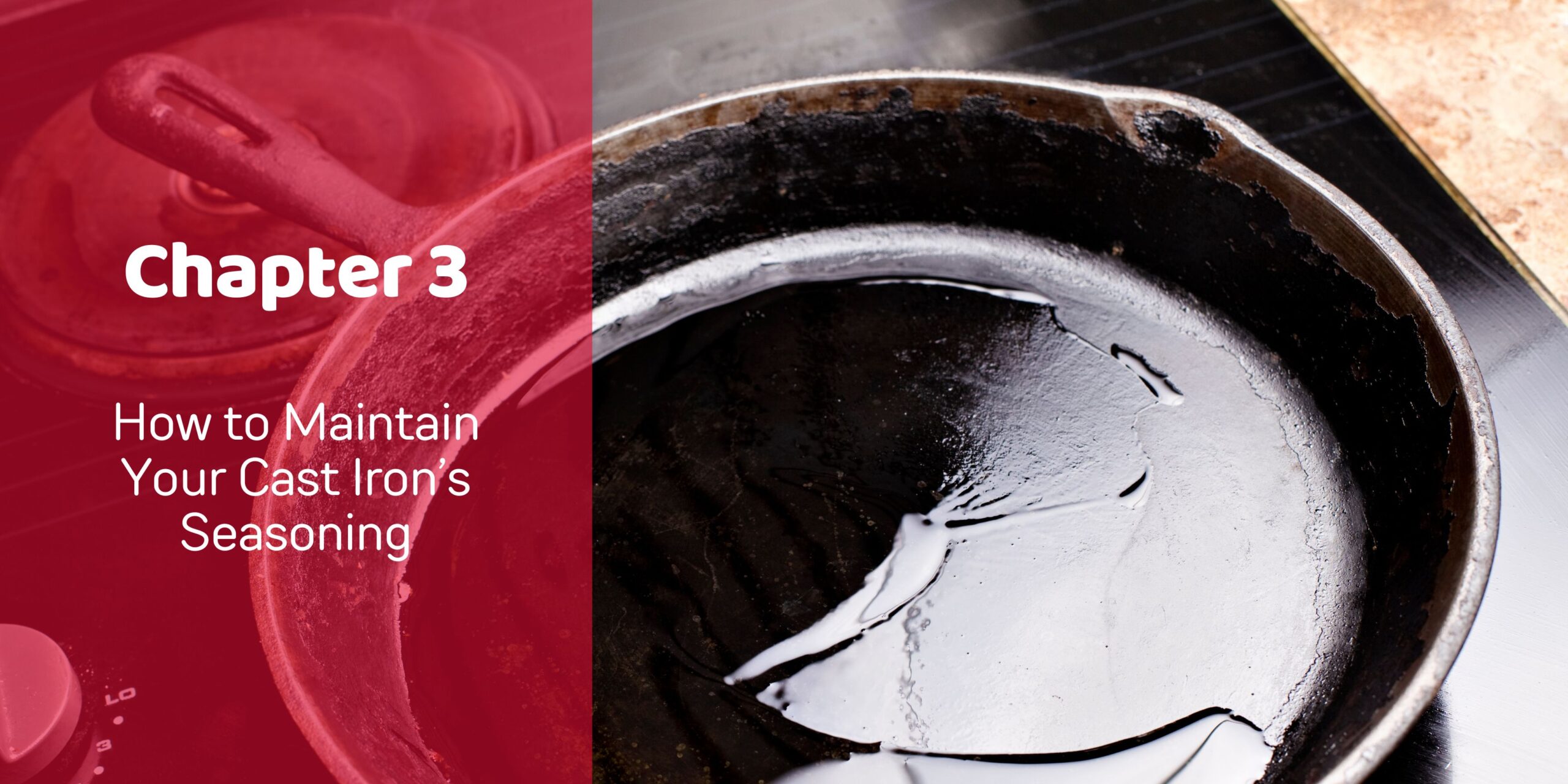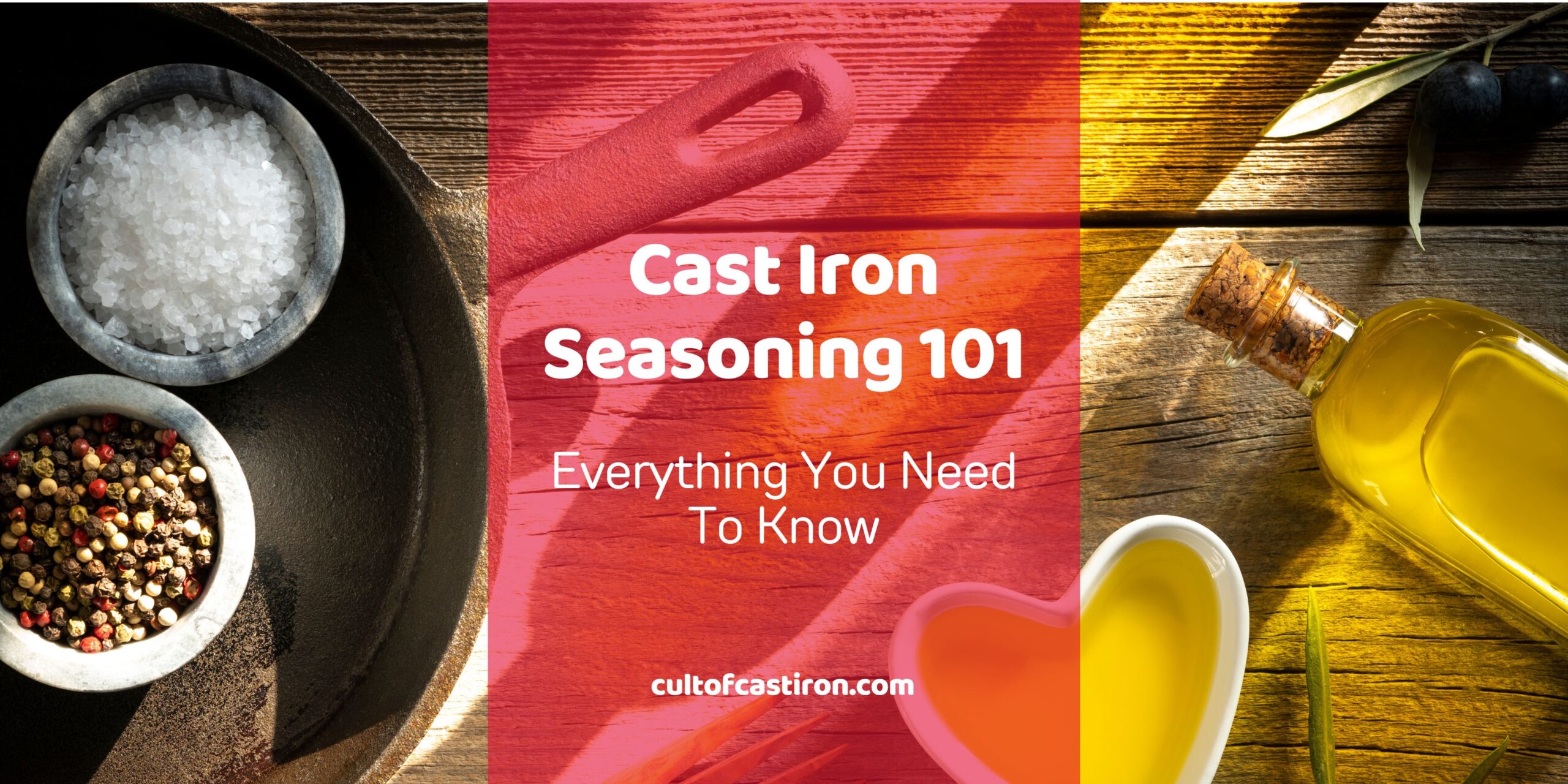In the world of cast iron cooking, there is perhaps nothing more enigmatic than the thin, black layer that coats the cast iron pots and pans – the seasoning.
A bare cast iron pan will be a nightmare to cook on its own as food can stick to its surface. Moreover, it will easily rust while in storage when it doesn’t have a protective layer shielding it from the elements. The cast iron pan’s trademark black patina won’t be anywhere in sight either. Borrowing from the famous phrase, I’d say that seasoning maketh pan.
With that said, there has been a lot of debate about the seasoning of cast iron pans: Which oil is the best to use for seasoning? Does it get damaged with soap? Is this thin black layer safe in the first place? In this article, I will do my best to answer these questions to help beginners start their cast iron cooking journey.
Chapter 1: What is cast iron seasoning?

The “seasoning” on cast iron cookware are made from layers of polymerized oil that are bonded to the bare cast iron metal that protects it from rusting while also giving it a slick surface that is great for cooking. With that, “to season” any type of cast iron cookware means coating it with oil and heating it until the oil polymerizes. But before we discuss this further, let us get familiar with polymers.
In the context of cast iron cookware, polymerization is the process of bonding multiple fat molecules using heat to produce a chainlike structure akin to plastic. Hence, the “seasoning” that we are referring to is actually a type of biopolymer.
How does cast iron seasoning work?
The science behind how cast iron seasoning works is actually quite simple: iron is hydrophilic, which means that its atoms are attracted to water and react to it. This reaction commonly manifests itself as rust. Hence, you must coat the iron with a layer of hydrophobic material – something that repels water – to prevent this from happening. Enter: the seasoning.
Apart from protecting the bare cast iron from rust, the seasoning also prevents food from sticking to the surface, and it does it in two ways.
First, the seasoning makes the cast iron surface smooth as the layer of oil essentially evens out the rough surface of cast iron cookware, thus reducing friction. This ensures that any food that is cooking on top of the pan will easily glide off the surface.
Second, its hydrophobic properties repel the water molecules in the food that you cook and prevent it from touching the bare cast iron below. This helps keep your food from sticking to your cookware.
Is cast iron seasoning safe?
Yes, ingesting bits of flaked-off cast iron seasoning poses no harm to people. Much of the fear regarding its safety stems from the notion that charred foods are carcinogenic. While the findings about acrylamide – a chemical found in starchy foods cooked in high temperatures – are still inconclusive at best, one thing is for sure: cooking oils do not contain acrylamide.
Besides that, the amount of flaked-off seasoning that you may be ingesting will be negligible. The best thing to do here is to season your cast iron cookware properly so that it won’t flake off in the first place.
What does pre-seasoned cast iron mean?
A pre-seasoned cast iron basically means that the pan already has a layer or two of seasoning applied during the production process. See, back in the day, cast iron cookware used to be sold in their bare form – those who purchased them will be the ones to apply the seasoning at home. Needless to say, this is quite a hassle, especially for modern consumers. Applying a coat or two of seasoning before it hits the shelves is how manufacturers solved this problem.
The type of oil used for the pre-seasoning varies per manufacturer. But just like any other type of seasoning, they do not pose harm if ingested in small amounts.
Chapter 2: How to properly season your cast iron cookware

Seasoning cast iron pans are easier than you think. However, one wrong move may change the result for the worse. But the best thing about cast iron is that you can start again from scratch if you have to. Here are the steps you have to accomplish to put a layer of seasoning onto your pan.
What should properly seasoned cast iron cookware look like?
Properly seasoned cast iron cookware should have a smooth and glossy surface that is dark in color. It should not be too greasy or too dull, and rust must not be present anywhere on the surface. And most important: it should also exhibit relatively good non-stick properties.
Some of the most common problems encountered when seasoning cast iron is flaking, peeling, and stickiness. More often than not, these problems can be solved by cleaning that piece of cookware and applying another layer of seasoning.
How often should you season your cast iron cookware?
The seasoning process is usually repeated occasionally to maintain the non-stick surface, and the seasoning can improve with use over time. Some people maintain a yearly or even quarterly schedule for seasoning their cast iron cookware.
Instead of sticking to a strict quarterly or annual seasoning schedule, I prefer to look for visual cues to know when to reseason my cast iron cookware. If I see that the pan is rusting or the seasoning is peeling, flaking, or sticky, then I know it’s time to put another layer of seasoning.
Can cast iron seasoning burn?
Yes, the seasoning on cast iron cookware can burn if it reaches temperatures way higher than its smoke point. Remember: polymerization does not mean burnt.
You’ll know that the seasoning is burnt if it turns ashen and flaky. But don’t worry, you did not ruin your cast iron pan – you only ruined its seasoning. The best thing to do here is to remove the burnt layer of seasoning from the pan and start from scratch. Here’s a quick guide on how to recover from a burnt cast iron pan.
What oil should you use to season cast iron cookware?
There are many options for the oil used for seasoning a cast iron pan. As such, each has its own characteristics and smoking points. Here are a few guidelines on choosing the best oil for seasoning your cast iron cookware.
Saturated vs. unsaturated fats
Cooking oils are broadly categorized into two categories: saturated and unsaturated fats. While both can be used for seasoning cast iron cookware, unsaturated fats does the job better than saturated fats.
Chemically speaking, saturated fats only have a single bond, and thus are less reactive compared to its unsaturated counterpart. This means that it is harder for this type of oil to form the polymerized chains necessary for seasoning. Saturated fats mostly come from animals (think: lard, butter, rendered animal fats, etc), however, some plant-based oils like coconut oil and palm oil are also under this category.
Meanwhile, unsaturated fats have double bonds and are more reactive than saturated fats. These fats come from plant sources like olive oil, canola oil, and avocado oil.
High vs. low smoke point oils
Yes, it’s recommended to use an oil with a high smoke point when seasoning a cast iron pan. Oils with a high smoke point, such as vegetable oil, canola oil, or grapeseed oil, can withstand high heat without burning.
Oils with low smoke points, like olive oil and sunflower oil, are not the best choice here as they may be more prone to flaking and peeling once the seasoning is burned off with high heat.
4 steps to season your cast iron cookware
All told, it will take around 30 minutes to a full hour to apply one layer of seasoning to a piece of cast iron cookware. However, much of the work is done after 5 minutes – the rest of the time, you’re just waiting for the timer to stop (or for the oil to dry). Here’s an overview of the full process:
1. Apply a coat of oil all over the pan
Assuming that your pan has already been cleaned beforehand, put a few glugs of oil on it and spread it all over the pan to coat its surfaces – including the handle and its backside as well. Make sure that there are no dull spots on the pan.
2. Wipe away excess oil
Putting too much oil on the pan can make the resulting layer of seasoning to peel and flake afterward. It can also leave a sticky black residue on the surface which is annoying to deal with. To prevent these from happening, you should wipe away excess oils from the pan with paper towels or a clean rag.
3. Heat the pan up to the oil’s smoke point
Knowing your cooking oil’s smoke point is crucial to produce a great layer of seasoning. You’ll want to hit the right temperature here – too low and it won’t polymerize properly; too high will cause the seasoning to flake off. Here’s a cheat sheet of the smoke points of different types of cooking oils.
Also, while seasoning in an oven is the easiest way to go, you can also do this process on a grill or a stovetop.
If you’re using an oven, pre-heat it to the temperature of the oil’s smoke point. From there, just put the pan inside face down to prevent the oil from pooling on the surface. You should also place something to catch any oil that may drip down from the pan to make clean-up easier. After that, you should set your timer to 1 hour and you’re pretty much done.
This process can be replicated in a grill, too! You must pre-heat the grill first, then place the pa n face-down on the grill. You should close the grills cover (if it has one) to replicate the environment of an oven. However, you may have a harder time keeping track of the temperature in a grill compared to an oven. If your grill does not have a built-in thermometer, your best bet is procuring a Bluetooth-connected thermometer to keep the temperature inside in check.
If you neither have a grill or an oven, then the stovetop is your only choice. While it is not particularly convenient, you can produce a great layer of seasoning using only your stovetop. Just place the pan face-up on the burner and gently heat it to the oil’s smoke point. You should invest in an infrared thermometer to aid you – however, you can probably tell that you’re in the right temperature if you see the oil lightly smoking.
You should stay vigilant when seasoning your pan on a stovetop as the oil may pool on the surface. You can wipe off this excess oil using a rag handled with thongs or an oven mitt. You’ll know you’re done when the oil looks dry (not burnt – more on this later).
4. Oil the seasoned pan again (and wipe off the excess)
Whether you’re going to put your pan back into storage or apply another layer of seasoning, the next step you need to do is to apply a coat of oil to your freshly seasoned cast iron pan.
Oiling your cast iron pan before storage prevents rusting. So, just like usual, apply a few glugs of oil all over the pan, then wipe off the excess. It will be ready for storage once it has cooled down.
If you want to apply another layer of seasoning, then do the steps in the sentence above, but instead of putting the pan back into storage, repeat step #3. You can repeat these steps for as many layers as you want.

Chapter 3: How to maintain your cast iron’s seasoning
Maintaining your cast iron cookware’s seasoning is relatively easy – just clean, dry, and oil the pan after use and you pretty much have all your bases covered. However, there are some other cast iron seasoning quirks that need to be demystified. This section aims to demystify these commonly asked questions.
Cooking acidic food in cast iron: will it damage the seasoning?
Acidic food can damage cast iron’s seasoning, especially if the cookware is not well-seasoned or is brand new. Acidic foods, such as tomatoes, vinegar, and citruses, can react with the iron in the cookware and cause the seasoning layer to break down.
However, if the cast iron cookware is well-seasoned and has a strong seasoning layer, cooking acidic foods in it should not be a problem as the seasoning layer will help protect the iron from reacting with the acid.
Cleaning cast iron with soap: will it break down the seasoning?
Yes, you can clean cast iron pans with soap, but it is important to do so carefully to avoid damaging the seasoning layer. Contrary to popular belief, using soap to clean cast iron cookware will not ruin the seasoning layer as long as you use it in moderation and rinse the pan thoroughly after cleaning.
The “you can’t clean cast iron with soap” myth most likely originated in the early 20th century when soaps made with lye were the only option for most households. Lye that could strip away the seasoning layer from cast iron cookware. Back then, it was common to use only hot water and a stiff brush to clean cast iron cookware, and many people avoided using soap altogether.
Thankfully, the dish soaps we have now are milder and won’t damage your cast iron’s seasoning unless you’ve failed to clean and dry them thoroughly afterward.
Cleaning cast iron with salt: how does it affect the seasoning?
Scrubbing the pan’s surface with salt is a popular and safe method of cleaning cast iron cookware. The salt acts as a mild abrasive that helps remove burnt bits and excess oil residue on the surface.
While big problems won’t arise when you are cleaning a cast iron pan with salt, it may remove some of the seasoning layers from the pan. The salt itself won’t react to the seasoning, but its abrasiveness may play a role in peeling off some specks of seasoning here and there, but this mostly happens when the pan and its seasoning is already in poor condition.
How often should you season a cast iron skillet?
Aside from seasoning your bare cast iron pan for the first time before use, there are no set requirements on how often you should season it throughout its life. However, most cast iron manufacturers recommend that you season your pan 2-3 times per year.
Instead of sticking to a strict quarterly or annual seasoning schedule, I prefer to look for visual cues to know when to reseason my cast iron cookware.
If you see one of the symptoms in the list below, then it’s time to re-season your pan. These visual cues are
- Heavy rusting
- Peeling and flaking seasoning layer
- Splotchy patina
- Sticky surface
However, don’t be quick to jump the gun either as some issues can be solved without the need for a full-on seasoning session. Light rusting on the surface of the pan can be solved by removing the rust with a scrubber and oiling the surface afterward. Meanwhile, an uneven patina can be resolved just by cooking and oiling your pan regularly.
Be a seasoned cast iron cookware user
With proper seasoning and care, cast iron cookware can last for generations. Whether you’re a seasoned cast iron cook or new to the game, understanding the basics of cast iron seasoning is key to getting the most out of your cookware.
If you’re still hungry for more info about cast iron and other cookware made from carbon steel, stainless steel, copper, and aluminum, then be sure to check out the rest of the Cult of Cast Iron blog!

Miguel is a cast iron enthusiast from Cavite, Philippines. He works in the digital marketing field as a content marketing strategist. On the side, he manages a small online bookstore and tends to his plants.

